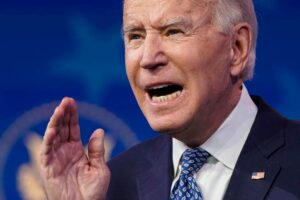Sep
4
Biden’s Student Loan Bailout: Irresponsible, Unfair, and UnChristian
“America’s children will be picking up the tab for this fiscal negligence for a generation.” — Lindsey M. Burke, director of The Heritage Foundation’s Center for Education Policy and Mark A. Kolokotrones fellow in education

Everyone is talking about President Biden’s plan to “cancel” student loan debt for millions of people, a move even a few noted Democrats are saying is a mistake. I’ve been trying to wrap my head around how many different ways and reasons why this plan is at best misguided — more cynically, but probably closer to the truth, a blatant attempt to win votes/support from certain segments of the population for Biden and others who go on record as approving the plan. So, I’m going to try to present those reasons here without getting lost in too much detail. (Go here, here, here, and the links below for more details.)
As per The Heritage Foundation’s Lindsey M. Burke and Adam Kissel, here is a nice summary of the issue at hand:
“About 93 percent of student loans originate with the U.S. Department of Education through the Direct Loan programs (Direct Subsidized Loans, Direct Unsubsidized Loans, and Direct PLUS Loan)…. On August 24, 2022, the U.S. Department of Education announced a plan to cancel $10,000 in student-loan debt for each borrower earning less than $125,000, up to $20,000 for each borrower under the income cutoff if that borrower received a Pell grant, and $250,000 if the borrower files taxes as married or as head of household. The Biden Administration also announced an extension of the student-loan repayment moratorium through December 31, 2022, which has permitted borrowers to delay required loan payments without accruing any interest since March 2020.”
Serious Legal Questions
A January 2021 memo from the Office of the General Counsel at the U.S. Department of Education clearly explains that the department has no authority to “forgive” or cancel student loans en masse. Principal Deputy General Counsel Reed Rubinstein argued that “the Secretary does not have the statutory authority to cancel, compromise, discharge, or forgive, on a blanket or mass basis, principal balances of student loans, and/or to materially modify the repayment amounts or terms thereof.” Rubinstein gave many reasons…. Speaker Pelosi is on record as agreeing with this assessment. Also, mass loan cancelation “might be appropriately and necessarily considered a legislative rule under the Administrative Procedure Act,” which would require a process of public notice and public comment. The Biden Administration didn’t do that.

The latest General Counsel’s memorandum accompanying the department’s cancelation announcement effectively rescinds the prior memo, calling it substantively incorrect. But the new memo offers no response to the prior counsel’s opinion that an act to cancel student debt for wide swathes of borrowers would be effectively legislative and need to proceed through notice and comment before going into effect. Moreover, the new memo fails to justify the Biden Administration’s chosen policy in the terms of the Health and Economic Recovery Omnibus Emergency Solutions (HEROES) Act, which purportedly authorizes the debt cancelations.
Economic Concerns
Original estimates for the cost of the student loan “forgiveness” was over $300 billion. After the Pell Grants were included, it went up to over $500 million, possibly nearing $600 billion. Extending the pause on loan repayments will add another $16 billion. (Each month federal taxpayers are losing $5 billion in accrued interest that will not be recouped, and have lost $155 billion since the pause first took effect. If you continued to make loan payments during the pause, you now can get a refund of those payments, bumping your balance back up to what it was in March 2020, and increasing the amount of forgiveness you receive.) The plan also includes major changes to existing income-driven repayment plans, which are available to income-eligible borrowers.
By the way, thanks to a provision slipped into the American Rescue Plan (which passed March 2021) by Sens. Warren (D-MA) and Menendez (D-NJ), any future student loan forgiveness is tax free until Jan. 1, 2026. This could add another $34 billion to the price tag.
Over the short term, this cost will be financed by increasing the national debt, which must ultimately be paid either with higher taxes or with even more inflationary money printing by the Federal Reserve. America cannot afford to gift hundreds of billions more to people who are comfortably off. It would only add to inflation.
On another note, absolving people of a debt reduces the incentive to work and reduces participation in the labor market. That retards economic output and drives up prices. Furthermore, repaying student loans would help reduce the money supply, taking the oxygen away from the inflationary fire and helping to keep down prices.
Regressive Nature
Yes, I said “comfortably off”. The distribution of student-loan debt is largely skewed toward upper-income earners, with the wealthiest 40 percent of Americans owing 60 percent of outstanding student-loan debt. The lowest 40 percent of earners by income distribution hold just 20 percent of outstanding student-loan debt. Pell students more often fail to graduate, and they more often attend two-year programs. As a result, they have lower incomes than non-Pell students. Even so, the plan remains highly regressive even with the income caps, particularly when factoring in the extended pause on repayments.

The Committee for a Responsible Federal Budget (CRFB) estimates that since the pause began, for example, those holding medical degrees have received the equivalent of $48,500 in debt cancelation due largely to the pause on interest accrual, while those with law degrees have received the equivalent of $29,500. The CRFB estimates that if the pause were to continue through August 2023, doctors and lawyers would have respective total benefits of $89,500 and $54,500 per person.
It is also worth noting that the vast majority of college grads remained in their jobs during the pandemic by virtue of remote work, and their unemployment rate is a mere two percent. Some 1.7 million more college grads have jobs today than before the pandemic. They are therefore more able to repay their student loans.
The more generous student loan forgiveness becomes, the more it benefits upper income earners. Speaking of…
Rewards Washington Elites
The American Accountability Foundation found that the 41-person political staff overseeing the student loan program at the Department of Education collectively owe between $2.8 million and $6.5 million in outstanding student loan debt. Another 30 senior White House staffers who were required to file a financial disclosure form owe as much as $4.7 million in student loan debt. Another benny for the young “woke managerial class”…
Blatantly Unfair
For those always talking about “social justice”, it is amazing how blind (or dismissive) they are to the unjust nature of the Biden plan. As has been pointed out many times, loan cancelation transfers the debt of an individual who freely agreed to repay a loan onto other individuals (through higher taxes and inflation) who did not agree to take out that loan. Many individuals made a conscious decision not to attend college in order to avoid debt. Loan cancelation foists someone else’s debt onto them. Others chose not to go to college because they believed it was a bad value proposition. Still others worked their way through college to avoid debt. Many borrowers lived modestly after graduation in order to pay down their loans.
The Biden debt transfer punishes the 240 million Americans who do not hold college degrees, who constitute more than half of the population ages 25 and above and are less able to bear this new burden. It also punishes the millions of responsible Americans who diligently repaid the loans they agreed to take out.

Discourages Taking Responsibility (and Other Moral Hazards)
It is also unfair to those who accrue such debt in the future. By opening the door to debt amnesty now, this Administration and future ones will face growing pressure for new rounds of amnesty. Student loan forgiveness would likely encourage colleges to raise tuition even higher, particularly if graduates expect student loans to be forgiven again in the future. But, colleges and universities are not the only entities that face perverse incentives to prolong and extend the student debt crisis by raising tuition and enrolling students who are unlikely to graduate or have sufficiently lucrative careers. Students also face moral hazards from debt cancelation and the easy money that has become even easier due to cancelation. If there likely will be more debt cancelation in the future, why save up? Why shop around? Why pay down debts? Why make sacrifices? These are fiscally wise practices and lessons that will not be learned.
Moreover, this cancelation rewards college dropouts. Students who receive Pell grants have to return the unearned amounts if they drop out of school before 60 percent of their current term has passed. Presuming that Pell debts are covered by the cancelation plan, students with Pell grants will have a new incentive to take a chance on future forgiveness. Many students and parents will make financially riskier decisions out of hope that the government will bail them out.
(Incidentally, that Pell Grant money is taxpayer money being loaned out. It needs to be repaid so that it can be used to pay for roads and other infrastructure, border security, military readiness, etc.)
Doesn’t Address the Real Problem
Open-ended federal subsidies have distorted the market for higher education, enabling colleges to raise tuition beyond what students and their parents otherwise would have been able to afford. Colleges and universities benefit from multiple billions of dollars in endowments (especially elite institutions like Harvard and Yale), and they spend money on buildings of questionable need, “woke” departments and personnel, and various campus extravagances. More fundamentally, this bailout does not address rising college costs. Rather, it will significantly exacerbate them. The possibility of future bailouts will drive more students to take on higher debt burdens, which many colleges will gladly encourage for the sake of increased tuition. (I know I just said something above along those lines, but it bears repeating.)

If the Biden Administration wants to make it easier for people to repay their student loans, government policy should make it easier for people to work and earn rising incomes. Instead, federal policies and anti-business actions not only have raised barriers to work, but also have driven rampant inflation that has erased $5,100 of value from the average worker’s paycheck over just the past year. That is far more of a burden than the entirety of the average annual student loan payment. If the Administration were serious about reducing college costs and providing relief to students and taxpayers, it would begin to wind down the federal student-loan program. In fact, as the Administration has tacitly admitted through the very act of canceling student loans, the existing federal loan program does not work.
Here is another relevant quote, this one from the staff at The Week UK:
“The system needs to change if we’re to escape this spiral of ever-rising college fees and debt, agreed Oren Cass on Politico. College should be financed by part-time jobs, means-tested grants and, if necessary, ordinary loans. If students need more funding for fancy colleges, that money should come from the colleges themselves. Just as car manufacturers provide financing for their vehicles, so colleges should do the same. That would incentivise them to control costs and ensure their students’ future career success. If the model pushed by college administrators isn’t working, ‘let them, not their students, suffer the consequences’.”
End Result
The Penn Wharton Budget Model now has the total cost of the move (inclusive of debt amnesty, the pause on repayments, and a much more generous income-based repayment plan) exceeding $1 trillion. This money already has been lent out to students over the years, so the loan amnesty (which the federal government had expected to recoup) will result in a shortfall in federal revenues. The federal government will have to finance this shortfall by deficit spending, printing money, or raising taxes.
The bottom line is that the Biden administration has put into motion a plan that will further inflate college costs, hinder economic growth, reward upper-income earners, and provide a major handout to woke institutions of higher education.

Bad “Christian” Arguments
Now, either due to ignorance or stubborn dismissal of the above, there are some Christians and non-Christians alike — typically those who lean towards SJW thinking and/or have their own student debt — who have been trying to guilt Christians into supporting Biden’s student loan “forgiveness”. Christianity is based on forgiveness, right? Isn’t it the loving and “Christian” thing to do to support an effort like this? It’s simply “Christian compassion”, after all. Any Christian who doesn’t buy into it, so to speak, is just mean or racist or something, and certainly thinking unChristianly….
Using facts like those laid out above and biblical principles, Christian blogger Samuel Sey wrote about why this rationale is wrongheaded. In summary, he points out that the Biden plan:
1) Promotes wickedness. (Psalm 37:21)
2) Will force many Americans into disobeying God’s explicit commandments about debt. (Rom. 13:7-8)
3) Is arbitrary and fraught with partiality, and is therefore unjust. (Lev. 19:15)
4) Will only create more injustice and suffering via inflation, etc.
Perhaps the saddest, yet most frustrating, part of the effort to guilt/bully Christians into supporting the student debt bailout is how some have the audacity to compare it with Christ’s work on the Cross. Author/columnist Kevin McCullough countered with the following:
“The debt that Jesus paid was first and foremost a literal debt that no human could have paid. There was no sacrifice that a fellow human could have made that would have satisfied the debt of even their own sin, much less that of [potentially] every person on earth. It took literally God Himself to make such an offer of love and sacrifice.
The students who all voluntarily took the money from the tax-payers sat through orientation classes carefully having explained to them how long and how difficult taking the money would make their lives until it was repaid. But they are able to repay it. It’s not an infinite amount and many who took it parlayed it into a law practice or a medical residency where they have the ability to charge high prices for their specialized knowledge.
Also, if Joe Biden’s policy was in any way similar to Christ’s offer, he would not be pointing the gun to the heads of others to enforce such ‘forgiveness.’ Jesus took it on Himself to pay the debt owed. Biden literally is hiring 87,000 additional armed [IRS] agents to come to your home and force you to give up more of what you’ve labored hard for to enforce ‘forgiveness.'”
Clearly, those pushing such an argument either don’t understand redemption through Christ or, at the very least, haven’t thought this through very well. Maybe they have an ulterior motive for not wanting to.
(H/T Lindsey M. Burke, PhD, and associates at The Heritage Federation; unless otherwise indicated, the bulk of this article’s text was either informed by Heritage articles, directly cited from them, or edited into shorter quotes, perhaps with a few words of my own for flow)















